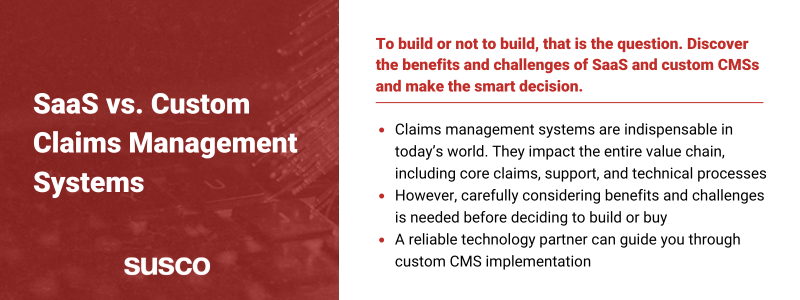To build or not to build, that is the question. Discover the benefits and challenges of SaaS and custom CMSs and make the smart decision.

The insurance landscape has evolved rapidly since the turn of the last decade. Today, a modern claims management system (CMS) is the bedrock of excellence. It supports digital channel enablement, automation of key processes, and robust data capture and analytics.
Forward-thinking independent adjusting (IA) firms are moving away from siloed legacy systems to modern ones for effectiveness and efficiency. You should, too.
There are two options: a software-as-a-service (SaaS) CMS or a custom CMS.
It’s a classic build vs buy scenario, and your decision directly impacts business success.
A simple analogy is that you need a new outfit for an important upcoming event. One option is walking to a store and picking something off the rack. It’s fast and inexpensive, but you may not get the perfect fit. Alternatively, you can have the outfit tailored specifically for you. This may cost more, and you’ll certainly wait a little longer, but you’ll be extremely sharp at the event.
This article explores the benefits and challenges of a SaaS and custom CMS to help you make the right call. Let’s dive in!
SaaS claims management systems
A SaaS CMS is a pre-built software solution designed to meet the general needs of IA firms. The model allows IA firms to enjoy the benefits of a modern CMS without getting bogged down by installation and upkeep.
Business justifications for a SaaS CMS include:
- Cost-effectiveness: The initial investments in a SaaS CMS are relatively low. Because it operates on a subscription basis, costs stay flexible and predictable. Ultimately, you pay only for what you need.
- Quick deployment and implementation: A SaaS CMS allows you to skip the development process. Plus, it’s relatively easy to install and configure, so you can get up and running in days, not months.
- Scalability: You can instantly scale capabilities (e.g., add users or increase storage) to meet new demands when the firm expands or handles more claims.
- Regular updates and maintenance: The SaaS provider handles all feature updates and security patches and keeps the CMS in top shape, freeing you to focus on critical business objectives.
It’s not all rosy with a SaaS CMS, though. Key challenges include:
- Limited customization: Configurability is often limited in SaaS CMSs because they’re designed for broad audiences. These systems’ one-size-fits-all approach is a major sticking point for those who want more control over the claims process.
- Potential data security concerns: While reliable SaaS CMS providers put their best foot forward to protect sensitive data, vulnerabilities can easily slip through the cracks because the security strategy isn’t tailored to your unique risk environment.
- Dependency on the service provider: Operations can be severely disrupted if the SaaS provider experiences downtime or closes shop.
Custom claims management systems
The benefits of a custom CMS include:
- Full customization: When building software from scratch, you have unfettered access to customization. You can integrate all essential features to streamline claims processes and workflows.
- Enhanced data security and control: Security is fortified by integrating key considerations across the development pipeline. Plus, there’s greater control of where and how data is stored and who has access to it.
- Compatibility: You can design the system for interoperability with your specific tools, such as your accounting and customer relationship management (CRM) software.
The drawbacks to opting for a custom CMS are as follows:
- Higher initial cost: At the start, you don’t just pay for software—you pay for development, testing, and implementation. These high initial costs can derail the project from taking off if a solid financial plan is not in place.
- Longer development and implementation time: Depending on the project’s complexity, the time between conception and implementation can be months. Therefore, you’ll need a strategy for handling claims before the custom CMS becomes operational.
- Ongoing maintenance and updates are required: You are entirely responsible for keeping the system at an optimal state, including maintenance, updates, and troubleshooting.
That said, you must carefully weigh the pros and cons of SaaS and custom CMS to determine which delivers better value for your business.
SaaS CMS vs. custom CMS: A comparative analysis
Generally, SaaS CMS implementation is quicker. The ready-made solution bypasses the develop, test, and deploy stages, which account for a significant chunk of the time in custom CMS implementation. SaaS CMSs are also natively scalable and can easily adapt to higher demands, something that custom solutions struggle with if not factored in from the start of development.
In contrast, a custom CMS offers more flexibility. You can mold it to align with business needs, regardless of complexity. It also delivers better data security and control as you can set up robust measures for your unique threat environment.
However, the better solution isn’t immediately apparent regarding cost. Calculating the total cost of ownership (TCO) is key to a comprehensive view of each solution’s financial implications.
How to choose the right CMS for your independent adjusting firm
Follow these steps to choose the right CMS:
- Assess your firm’s specific needs and requirements.
- Weigh the TCO against budget constraints and business goals to determine which option makes the most financial sense in the short and long term.
- Evaluate which solution best accommodates business growth.
- Conduct due diligence on potential vendors and partners. Check their track record, references, and client reviews to ensure you entrust your business to someone reliable.
- Get a free assessment or consultation. Use it to ask questions, understand the company’s capabilities, and see a demo.
Custom CMS solutions from Susco
Susco is a leading technology solutions provider for forward-thinking IA companies. We build custom, human-centered software that unlocks efficiency and effectiveness throughout the claims cycle.
Book a free consultation now to learn more.